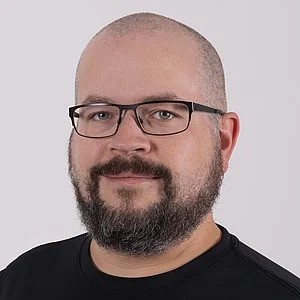
T3CON24 Recap – From SysAdmin to Platform Engineer: Crafting Tomorrow’s Tech Talent
From SysAdmin to Platform Engineer: Cultivating Next-Gen Tech Talent
As web infrastructure becomes increasingly complex, who will build and maintain the digital world of tomorrow? At T3CON24, Martin Helmich and Maximilian Hafer addressed this crucial question in their session, From SysAdmin to Platform Engineer: Crafting Tomorrow's Tech Talent, exploring not just how technology is changing, but how we can prepare the next generation to embrace these challenges. They presented a compelling case for early technology education, fostering technical passion and collaborative skills in today’s youth — the people who will be running the web in 10 to 20 years.
The Evolution of Web Technologies
Martin Helmich opened the session with a reflection on his 20-year journey in web technology, recalling the first website he built with TYPO3 version 3.7 in 2004. “In those days, tech seemed relatively simple. We had Apache, we had PHP, we had MySQL, and nothing else. Life was good,” he reminisced.
That simplicity stands in stark contrast to today’s cloud-native landscape. The transformation has been profound — from virtualization to containers, from basic hosting to sophisticated cloud platforms, each advancement has added layers of complexity to the web developer’s toolkit.
Navigating cloud-native career paths requires an understanding of the vast and rapidly growing Cloud Native Computing Foundation (CNCF) landscape, which illustrates the complexity facing today’s IT professionals. This overwhelming diagram displays hundreds of projects and tools across the cloud-native ecosystem. “You can see it doesn’t even fit on the screen,” Helmich noted.
Maximilian Hafer built on this point: the CNCF landscape “really shows how fast tech is moving. Every day, new technologies arise, new technologies have to be heard about, and should be learned.”
The evolution of web technology has been accompanied by significant changes in how operations teams work. Helmich recalled the early days of siloed IT operations: “I still remember those days where I was building software, and when I was done, I threw it over the fence to the operations guys and said, ‘Good luck!’” This fragmented approach has since evolved into more collaborative models, with IT roles becoming increasingly interconnected and interdependent.
These developments raise a critical question about the future: How are we preparing the next generation of IT professionals to manage these increasingly complex systems?
“Whoever will be running the web in 20 years, those are the people being born today,” Helmich emphasized. “If we want to talk about what the web will look like in 20 years, we have to think about how to engage people who are being born today so they can keep the web running.”
The Digital Native Paradox
While today’s children grow up surrounded by technology, they often engage with it only as consumers, rather than creators. This disconnect represents a paradox of modern technology education.
“Technology has gotten so easy to use. Kids these days are growing up with smartphones,” Helmich observed. The intuitive interfaces of modern devices, while user-friendly, hide the underlying complexity that makes them work.
This has led to surprising knowledge gaps even among computer science (CS) students. “I’ve seen CS students who don’t know how a file system works,” he shared. “We have young adults who have never worked on a computer, even if they’re doing CS classes in high school.”
Hafer emphasized the core challenge: “We have to try to bring the kids and teens today to a point where they’re not just consumers of this technology. They are really excited about AI models and ChatGPT, but we have to bring them to a point where they reach the same realization we had: It’s great to build software. It’s great to build infrastructure.”
The speakers noted that natural curiosity and inclination toward technology isn’t universal. “Not everybody has the means, the opportunity, or knows where to start with their own projects,” Helmich explained, highlighting the need for structured pathways into technical education.
Education for Future Tech Talent
As part of ongoing tech talent development, Hafer works with codefryx, a non-profit educational program founded in 2022 that offers courses for children and teens aged 7 to 18.
The codefryx approach is built around fostering intrinsic motivation rather than simply teaching technical concepts. Their curriculum is designed to create transformative moments where children connect emotionally with technology creation.
“Most kids and teens have a really big ‘aha’ moment where they’re like, ‘Oh, this is so cool! I’ve built my own robot!’” Hafer remarked. These breakthrough experiences spark genuine interest that drives further learning.
The program’s curriculum follows a thoughtful progression. For younger children, they offer introductions like Lego robotics and creative coding. “In these courses, they can learn in a very playful way.” This scaffolding approach then builds enthusiasm for more advanced topics: “They really want to move to our advanced courses. They want to build machine-learning models, they want to develop their own games.”
Unlike many educational programs for young coders, codefryx focuses on offline, in-person learning. Hafer emphasized why this approach matters: “This is not a one-person job. The days of the one-person army DevOps guy are over. We work in really complex, large teams and soft skills are becoming more important than ever.”
Another key element is their work with educators. “We also offer programs for teachers where they can learn how to improve their CS classes,” Hafer explained. By training teachers, they can “widen our reach quite dramatically,” extending their impact well beyond direct student interactions.
Site Reliability Engineering (SRE) as a Model for Teams
How should we introduce the nature of contemporary teamwork to the next generation?
Helmich noted the proliferation of terms to describe the complex structures in which modern web engineers work: DevOps, DevSecOps, MLOps, platform engineering, and Site Reliability Engineering (SRE). Helmich highlighted SRE as particularly valuable: “If we ask ten people what they think DevOps means, we’re going to get twenty different answers.” By contrast, “SRE is a discipline that is actually clearly defined.” He recommended Google’s books on SRE for those interested in learning more about the framework.
A core principle of SRE is eliminating what Helmich called “toil” — “mindless, repetitive tasks that are easily automated.” He explained why automation is essential for scaling: “If you have a general infrastructure and you need a lot of repetitive manual tasks to keep it running — how’s your engineering team going to scale? Double the servers, double the systems... We’re not getting twice the people.”
This aligns perfectly with preparing the next generation, as Hafer explained: “Generation Alpha doesn’t want to have toil. So start automating now.”
Equally important is the blameless “postmortem” culture that SRE promotes. Helmich noted that in modern operations, “You’re expecting engineers to write in detail what went wrong, why it went wrong, what you learned from it — and it all has to be blameless.” This transparency and learning-focused approach mirrors how codefryx teaches collaboration to children.
The same collaborative, automation-focused, and learning-oriented mindset that successful tech organizations cultivate is precisely what educational programs should instill in young people from the beginning.
How Companies Can Support Young Tech Talent
Hafer and Helmlich recognized that educational programs for young coders like codefryx can’t solve the talent pipeline challenge alone. Businesses play a critical role in tech talent development, and must also contribute to fostering the next generation of web engineers.
“You and your companies can do it too,” Hafer encouraged. “You can ensure that in the future, in three years, you will still have great developers, great marketing experts, great people who visit these conferences to network with other companies.”
The speakers outlined several approaches businesses can take:
- Invest in early partnerships. Engaging children when they are young helps spark interest in technology before they form fixed ideas about it. Early exposure makes them more motivated to explore new concepts.
- Offer internships and mentorships for older students. These experiences should focus on students' interests rather than company agendas, helping them develop relevant skills in areas they’re passionate about.
- Share industry knowledge through school outreach. Many educational institutions welcome experts from tech companies to speak with students, offer hands-on learning opportunities, and inspire the next generation of professionals.
Conclusion: Tech Talent Requires Long-Term Investment
The path to fostering technical talent requires patience and long-term thinking. When asked about the return on investment for educational initiatives, Hafer used a musical analogy: “One of the hardest things about teaching people who don’t play an instrument yet how to play is that you can’t just start and expect great outcomes immediately.” Helmich reinforced this point: “This is not one of those four-week boot camps. There’s no immediate payout. You have to be patient.”
By preparing the next generation of IT professionals — focusing on collaboration, intrinsic motivation, and creative problem-solving — we build the foundation for a web that can continue to thrive for decades to come. The specific technologies will change, but the collaborative mindset and passion for innovation are timeless qualities that will serve the next generation of tech professionals well.
Did you enjoy this recap? If you would like to relive all the exciting moments from T3CON24, be sure to check our our recap of the entire conference!







